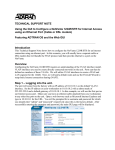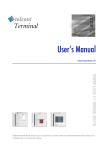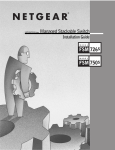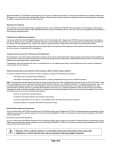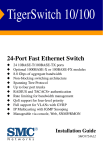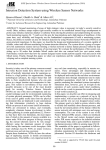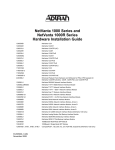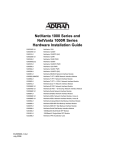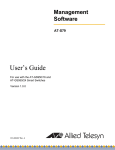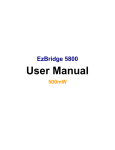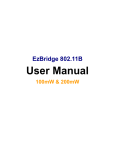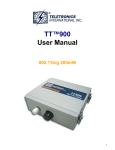Download NICE-PRICED
Transcript
® MAY 12, 2005 I WWW.NWC.COM $ A F F O R D A B L E I T : LOW-END SWITCHES NICE-PRICED SWITCHES A decent Ethernet switch for less than $750? Our findings BY JOE HERNICK AND DEAN ELLERTON may surprise you It’s amazing what a modest amount of money will get you in the switch market. NETWORK COMPUTING put out a call for inexpensive, managed Ethernet switches with enterprise features—specifically, a 24-port 10/100 switch with at least one Gigabit Ethernet uplink port that retails for less than $750. Administrative tools were an important consideration in terms of quality and type, especially with respect to VLAN (virtual LAN) and port configuration. Although we weren’t looking for raw throughput or performance, we did want easy setups, support coverage and management, and monitoring options, such as SNMP support. We weren’t expecting the world with these switches. But an administrator with only a basic understanding of network concepts should be able to set up and maintain these products using only publicly available sources, such as the user manual and vendor Web site. Adtran, Allied Telesyn, Netgear, ProCurve Networking by Hewlett-Packard and SMC Networks rose to our challenge, with Allied and Netgear shipping us two models each, for a total of seven switches. The ProCurve 2626 wins our Editor’s Choice award, delivering the best overall value with a sweet lifetime warranty, reasonable pricing, flexible uplink options and an excellent management interface. However, if you have minimal functionality needs, the Netgear FS526T is a good choice at an exceptional price. If you know your users will be running VoIP (voice over IP) or some other application that requires QoS (quality of service), also consider Allied Telesyn’s AT-8524M. How We Tested Our tests were straightforward: We unboxed the gear and included sundries, set the base IP over a serial connection to the console port (one contender didn’t have a management port), connected a test workstation, and ran the Web interfaces through the ringer over Internet Explorer, Firefox and Safari browsers to set up virtual LANs, review port status and activate SNMP monitoring. We tested uplinks where available, and all units connected to our core switch with no problems. HP ProCurve’s solid, Java-based Web client offers setup, configuration and testing tools via HTTP or HTTPS. We used Dartware’s InterMapper to test SNMP probes with consistent results in compatibility (support of SNMP1 and SNMPv2c) and reporting of interface traffic, statistics and switch description. Our testing relied on SNMP get requests and queried the ifNumber value of the MIB 2 subset to report the number of interfaces on the switch. We also ran a full snmpwalk from a BSD Unix client to check out the information offered. Among the participants, only one switch—Netgear’s FS526T—doesn’t support SNMP. Our ratings are based on ease of setup, feature set, ongoing management, physical design, warranty and overall value of the switch. Because this is an Affordable IT review, we rated pricing as most important. Hewlett-Packard Co. ProCurve Networking ProCurve 2626 The ProCurve 2626 had consistently solid scores, _ keeping it at the head of the pack. At $699, the ProCurve wasn’t the cheapest of the lot, but the lifetime warranty fills us with warm, fuzzy feelings. Out of the box, the ProCurve’s excellent paper and CD-ROM manuals, clear installation guide, bundled serial cable and rackmounting hardware gave us everything we needed to get up and running quickly, without any hassles whatsoever. Console management is straightforward: We opened a telnet session, logged in with the default settings, switched to the menu system and easily set up addressing. The Java-based Web client is intuitive and provides excellent management and testing tools over HTTP or HTTPS (see screen on page 1). We installed our security certificate with no problems over the Web client to get SSL in place. Although SNMP community names had to be set using the command-line menu system instead of Editor’s the Web client, the ProCurve played Choice nicely with our monitoring tools, speaking SNMP1 and SNMPv2c. The switch returned interface status and traffic stats, provided a self-description, and gave us A ★ ★ AFFORDABLE IT LOW-END SWITCHES If your hardware infrastructure isn’t strictly single-vendor and you don’t have too many enterprise-oriented management needs, inexpensive Ethernet switches have more to offer than you might think. In this installment of Affordable IT, we explore budget-friendly switches from Adtran, Allied Telesyn, Netgear, ProCurve Networking by Hewlett-Packard and SMC Networks, each with a retail price of less than $750. We tested these switches for ease of setup and manageability, and determined which features meet enterprise needs. We also evaluated SNMP support and even found an inexpensive model that supports QoS. Finally, we discovered which have user-friendly interfaces and which require a little more administrative finesse. HP’s ProCurve 2626 earned our Editor’s Choice award for its superior management interface, reasonable pricing and lifetime warranty. You can find all our Affordable IT articles at www.nwc.com/affordable_it. verbose detail from an snmpwalk command. The ProCurve was one of the quietest switches in the test and in the middle of the pack for boot-up speed, passing packets about 43 seconds once it got running. You can stack it with other ProCurve family switches and/or uplink over the 1,000-Mbps or mini-GBIC (Gigabit Interface Converter) ports to integrate into your existing infrastructure. ProCurve 2626. ProCurve Networking by HP (800) 975-7684, (281) 370-0670. www.procurve.com Netgear ProSafe 24 Port 10/100 L2 Managed Stackable Switch (FSM726S) and ProSafe 24 Port 10/100 Smart Switch (FS526T) The closest thing to a plug-and-play product in this review, Netgear’s entry-level FS526T is a basic managed switch that’s well-suited to a large home office or + small office setup. The FS526T lacks a console port, and it uses a bundled Windows application, “Smartwizard Discovery,” to set the base configuration. Although the setup application worked, we initially managed the product using the default IP listed in the documentation with a browser. In keeping with its dollar-store theme, the FS526T doesn’t support SNMP. Although this bargain box earned only a “C” grade, its ludicrously low cost per port should make it an attractive option for anyone looking for basic functionality from a small switch. As a bonus, it has the fastest boot time of any product we tested, at less than 13 seconds. If you just need to wire up a small workgroup, the FS526T will take care of your needs without any bells and whistles. The FSM726S has a lot going for it with a front-mounted console port, 24 10/100 ports, 2-Gbps copper ports and two empty GBIC slots. The console interface includes a wellthought-out menu-based wizard for the initial setup. Its automated assist—the only one among the products tested—was a welcome touch that more vendors should emulate. It’s especially helpful to novices setting up small networks. With the base configuration in place, the Java-based GUI is snazzy. It provides real-time graphic updates of port status and offers easy access to system management, making it the best management interface among the products we tested. Our favorite GUI feature is the pop-up warning that cautioned B C Netgear’s “nanny guard” provides warning prompts for important and potentially dangerous configuration changes. against altering critical settings, as by changing VLANs, trunking or setting the SNMP community string (see screen, page 2). The FSM726S requires an administrator to enable SNMP through the Web interface, then set up both community names and the SNMP host name. This three-step process makes for smart security, but it might be tricky for a novice. As with most of the products we tested, the FSM726S supports SNMP1 and SNMPv2c, returning interface and traffic stats, system description and full information from our snmpwalk. ProSafe 24 Port 10/100 L2 Managed Stackable Switch with 2-GB ports (FSM726S); ProSafe 24 Port 10/100 Smart Switch with 2-GB Ports (FS526T). Netgear, (888) NETGEAR, (408) 907-8000. www.netgear.com Allied TeleSyn’s straightforward Web interface provides a clean and clear management environment. Allied Telesyn AT-8026T and AT-8524M Allied Telesyn sent us two offerings: the economy AT-8026T with two fixed copper Gigabit uplinks at $529, and the midrange AT-8524M with two empty module slots for $649 plus an AT-A46 Gigabit copper uplink module for $95, which let it squeak in at $6 under + our $750 cutoff. Both models come with a limited lifetime warranty. We wouldn’t want to be the admin setting up either of these switches in a remote office. There are no quick-start guides, and the incomplete CD manual actually directs you to the company’s Web site for model-specific setup documentation. We downloaded the documentation, and from there the setup for each unit using the menu-based console was straightforward, if cumbersome. We used the AT Web management tool to enable SNMP and set community names without a hitch. Both support SNMP1 and SNMPv2c and returned interface and traffic stats, system description and full information from the executed snmpwalk command. We were impressed with the clear, straightforward Web management interface (see screen above), and aside from the setup snags, the AT-8524M is a solid product with a strong feature set. It is the only product we tested that offers Layer 2 QoS. The included Gigabit Ethernet module provides autoconfiguration and is hot-swappable. The AT-8026T uses the same management interface as its B C more expensive sibling but lacks QoS and ACL (access-control list) support. More disturbing, the product specs claim SSH (Secure Shell) support but we couldn’t get it to work. If you don’t need QoS, the less expensive AT-8026T switch with its two builtin Gigabit ports is the better value of the two. Both Allied Telesyn products were in the middle of the pack on noise output and boot times. AT-8026T, AT-8524M, AT-A46. Allied Telesyn, (800) 424-4284. www.alliedtelesyn.com Adtran NetVanta 1224ST The NetVanta 1224ST was one of two products we tested that uses female serial ports for console management, but Adtran doesn’t supply a cable + with its kit, so we had to track down a gender changer. The NetVanta box offers the standard 24 10/100 ports as well as 2-Gbps T ports and two mini-GBICs for $711. The five-year warranty shows confidence in the product, and anyone familiar with a Cisco command line will be comfortable with the console on the 1224ST. If you’ve never typed conf t, base setup might be tricky on this switch but manageable with the manual in hand. The 1224ST supports telnet but not SSH. The excellent Web interface has a clean GUI that allows easy setup of VLANs, port controls and other features (see screen, page 4). C REAL-WORLD® LABS REPORT CARD: LOW-END SWITCHES Hewlett-Packard ProCurve Netgear 2626 FSM726S Allied Telesyn AT-8026T Allied Telesyn AT-8524M Adtran NetVanta 1224ST Netgear FS526T SMC TigerSwitch SMC6724AL2 3.5 4 3.5 1 2.5 4.5 2.5 COMMAND LINE AND INITIAL CONFIGURATION (18%) 4.7 4 3 3 3 3 2 FEATURE SET 4.5 4 4.5 5 3.5 1 3 4.5 4.8 4 4 4 2.5 1 5 4 5 5 4 4 1 4.5 3 3.5 3.5 3 1 2.5 TOTAL SCORE (100%) 4.40 4.09 3.95 3.47 3.34 2.98 1.96 A≥4.3, B≥3.5, C≥2.5, D≥1.5, F<1.5 A-C GRADES INCLUDE + OR – IN THEIR RANGES. TOTAL SCORES AND WEIGHTED SCORES ARE BASED ON A SCALE OF 0-5. A– B+ B C+ C+ C D PRICE (23%) (18%) HTTP MANAGEMENT WARRANTY (18%) (18%) PHYSICAL DESIGN AND UPLINKS (5%) Customize the results of this report card using the Interactive Report Card®, a Java applet, at www.nwc.com. pants to provide paper documentation, the switch’s front console port is useful, and the unit runs quietly. Although we didn’t see anything that would immediately lower our confidence, if SMC only has enough faith to provide three months of support, you might want to spend your $399 elsewhere. This box had the slowest boot time of the lot. It was so lethargic on start-up that we initially thought we had a defective console port or cable. Boot time isn’t as crucial in a seldom-bounced device, but all the other switches we tested booted in less than 65 seconds while the TigerSwitch took 157 seconds before it began passing packets. The switch offers telnet, SSH and HTTP switch management, but its console is a bit clunky (Cisco-esque command line only) and the Web interface is neither well-organized nor intuitive. Another oddity: The “quick start” information wasn’t in the installation manual, but in the included management guide. SNMP setup was straightforward—we set up community names using the browser interface. SMC’s product was the only switch in our tests with public and private already set to defaults. This might be a convenience for some, but it’s a security risk. After resetting access passwords, we were up and running with SNMP 1 and SNMPv2c, receiving expected results from probes and snmpwalk. Two expansion ports are available; no GBIC or uplink cards were provided for our tests. Adtran NetVanta’s GUI makes it simple to set up features such as virtual LANs and port controls. Adtran’s Cisco-speak carries over during the SNMP setup. We activated SNMP using the Web interface, then had to go to a command line to set community name—you don’t get menu options or assistance. But a novice could learn the OS by using the online Adtran Operating System Command Reference Guide 9.1. Once configured, all SNMP probes and snmpwalk functioned as expected, returning stats and description. On a positive note, the whisper-quiet fan is the stealthiest of the lot, and the overall industrial design of the case is top-notch. TigerSwitch SMC6724AL2. SMC Networks, (800) SMC-4YOU, (949) 679-8000. www.smc.com NetVanta 1224ST. Adtran, (800) 9ADTRAN, (256) 963-8000. www.adtran.com JOE HERNICK, PMP, MS, is director of IT at the Loomis Chaffee School. DEAN ELLERTON, MS, is the CIO at Suffield Academy. Write to them at [email protected]. SMC Networks TigerSwitch SMC6724AL2 SMC’s D TigerSwitch 10/100 finished last mainly because of its scant 90-day warranty and quirky interface. In SMC’s favor, it was one of the few partici- LOW-END SWITCH FEATURES Adtran NetVanta 1224ST Allied Telesyn AT-8026T Allied Telesyn AT-8524M Hewlett-Packard ProCurve 2626 Uplink ports Two 1,000; two mini-GBIC Two 1,000 Two empty slots for 1,000 or GBIC Two 1,000; two mini-GBIC slots Console port Rear, female Rear Rear Rear None Front Front Interface options FTP, HTTP, SNMP, telnet FTP, HTTP, SNMP, telnet FTP, SSH, SNMP, telnet HTTP, HTTPS, SSH, SNMP, telnet HTTP FTP, HTTP, RMON, SNMP, telnet HTTP, SSH, SNMP, telnet $711 $529 $649 ($744 as tested) $699 $187 $380 $399 MSRP Warranty Notes NWC Netgear FS526T Two 1,000 Netgear FSM726S SMC Networks TigerSwitch SMC6724AL2 Two 1,000; two Two empty slots empty GBIC slots for 1,000 or GBIC Five years Lifetime Lifetime Lifetime Five years Five years 90 days Quiet; sharpestlooking case Had to go to Web site for setup docs ACLs and QoS, but had to go to Web site for setup docs Testing tools (ping, trace) included in Web interface Small-office switch Best Web interface Slowest boot time Copyright© 2005 by CMP Media LLC, 600 Community Drive, Manhasset, NY 11030. Reprinted from NETWORK COMPUTING with permission. 5905




